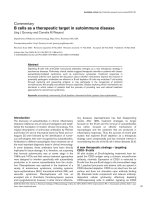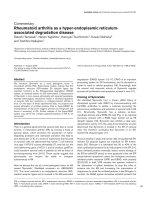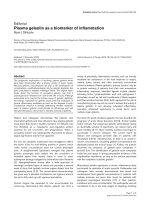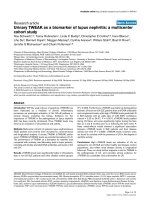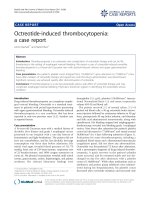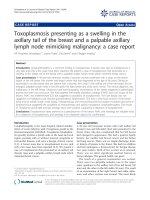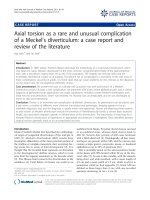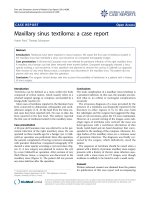Báo cáo y học: "Celiac disease as a potential cause of idiopathic portal hypertension: a case report" pdf
Bạn đang xem bản rút gọn của tài liệu. Xem và tải ngay bản đầy đủ của tài liệu tại đây (396.9 KB, 4 trang )
BioMed Central
Page 1 of 4
(page number not for citation purposes)
Journal of Medical Case Reports
Open Access
Case report
Celiac disease as a potential cause of idiopathic portal hypertension:
a case report
Farhad Zamani
1
, Afsaneh Amiri*
1
, Ramin Shakeri
2
, Ali Zare
3
and
Mehdi Mohamadnejad
1,2
Address:
1
Gastrointestinal and Liver Disease Research Center, Firouzgar Hospital, Iran University of Medical Sciences, Tehran, Iran,
2
Digestive
Disease Research Center, Shariati Hospital, Tehran University of Medical Sciences, Tehran, Iran and
3
Department of Pathology, Firouzgar Hospital,
Iran University of Medical Sciences, Tehran, Iran
Email: Farhad Zamani - ; Afsaneh Amiri* - ; Ramin Shakeri - ;
Ali Zare - ; Mehdi Mohamadnejad -
* Corresponding author
Abstract
Introduction: Idiopathic portal hypertension is a disorder of unknown etiology, clinically
characterized by portal hypertension, splenomegaly and anemia secondary to hypersplenism.
Case presentation: A 54-year-old man was admitted to our hospital for evaluation of malaise,
weight loss, abdominal swelling and lower limb edema. His paraclinical tests revealed pancytopenia,
large ascites, splenomegaly and esophageal varices consistent with portal hypertension. Duodenal
biopsy and serologic findings were compatible with celiac disease. His symptoms improved on a
gluten-free diet, but his clinical course was further complicated with ulcerative jejunoileitis, and
intestinal T-cell lymphoma.
Conclusion: It seems that celiac disease, by an increased immune reaction in the splenoportal axis,
can result in the development of idiopathic portal hypertension in susceptible affected patients.
Introduction
Idiopathic portal hypertension (IPH) is a disorder gener-
ally classified as a noncirrhotic portal hypertension of
unknown etiology, and is clinically characterized by por-
tal hypertension, splenomegaly and pancytopenia [1].
In some cases, IPH may be related to autoimmune reac-
tions and immunologic abnormalities [2]. On the other
hand, celiac disease (CD) is an immune-mediated enter-
opathy due to the ingestion of a gluten containing diet. It
has been suggested that in CD the deposition of circulat-
ing immune complexes originating from the small bowel
may cause other diseases [3]. The association of CD with
IPH has been recently reported in the literature [4-6].
Here we report on a patient with celiac disease compli-
cated by idiopathic portal hypertension, whose symptoms
and signs of portal hypertension improved on a gluten
free diet (GFD). However, the patient's clinical course was
further complicated with ulcerative jejunoileitis and intes-
tinal T-cell lymphoma.
Case presentation
A 54-year-old Iranian man was admitted to our hospital in
May 2006 because of malaise, weight loss and edema of
the lower limbs beginning 2 months prior to admission.
He also had a history of iron-deficient anemia and
increasing abdominal swelling for 8 months prior to
admission. On physical examination he was cachectic and
Published: 16 February 2009
Journal of Medical Case Reports 2009, 3:68 doi:10.1186/1752-1947-3-68
Received: 28 April 2008
Accepted: 16 February 2009
This article is available from: />© 2009 Zamani et al; licensee BioMed Central Ltd.
This is an Open Access article distributed under the terms of the Creative Commons Attribution License ( />),
which permits unrestricted use, distribution, and reproduction in any medium, provided the original work is properly cited.
Journal of Medical Case Reports 2009, 3:68 />Page 2 of 4
(page number not for citation purposes)
pale in appearance, with normal vital signs. The conjunc-
tiva was pale. Chest and heart were normal. On abdomi-
nal examination, tense ascites was detected. There was
also a 2+ pitting edema of the lower limbs. His initial lab
tests were normal except for anemia, thrombocytopenia
and leucopenia (Table 1).
Abdominal sonography revealed splenomegaly (23 × 7
cm) and large amounts of ascites. Portal vein diameter
was 18
mm
with a blood velocity of 25 cm/s. Duplex dop-
pler ultrasonography of the splanchnic venous system was
consistent with portal hypertension. Ultrasound showed
no evidence of vascular obstruction in the splenoportal
axis. On CT scan, there was no lymph node enlargement
compressing the portal splenic axis.
Eosophagogastroduodenoscopy showed four columns of
grade three esophageal varices with red signs, small gastric
fundal varices and moderate portal hypertensive gastrop-
athy. The duodenal bulb was normal but the second part
of the duodenum had atrophic folds and scalloping.
Results of duodenal biopsy revealed lymphocyte infiltra-
tion, crypt hyperplasia and villous atrophy compatible
with CD, grade Шb according to the Marsh classification
[7] (Figure 1). Serologic studies revealed positive anti tis-
sue transglutaminase (tTG) and anti endomysial antibody
(EMA). Percutaneous liver biopsy revealed mild non-spe-
cific chronic hepatitis.
Liver function tests including serum albumin and pro-
thrombin time were normal. Hepatitis B surface antigen,
hepatitis C antibody, and human immunodeficiency virus
antibody were negative.
Serologies were not consistent with autoimmune hepati-
tis, or primary biliary cirrhosis. Anti-nuclear antibody
(ANA), anti-smooth muscle antibody (ASMA), antiobod-
ies to anti-liver/kidney microsomes (ALKM-1), antimito-
chondrial antibody (AMA), and anti-liver cytosol antigen
antibody (ALC-1), were negative. The serum gammaglob-
ulin level was normal.
A gluten free diet was advised. At a 3 month follow-up
visit, the patient had gained 3 kg; and his hemoglobin,
platelet count and white blood cell count were increased
(Table 1). On physical examination there was mild
peripheral edema, and only a small amount of ascites.
Furthermore, his spleen size decreased to 17 × 6 cm by
ultrasonography. He did not return for follow-up visits
until 1 year later, when he was admitted again to our hos-
pital because of progressive malaise, anorexia, diarrhea,
abdominal pain and weight loss. He had not been compli-
ant with a GFD in the past year despite our recommenda-
tion. Abdominal CT scan showed splenomegaly,
thickening of the small intestine, and multiple soft tissue
densities in the mesentery. Push enteroscopy revealed
multiple jejunal ulcers and a mass lesion, which was biop-
sied. Seven days later the patient developed an acute
abdomen and underwent an emergency laparotomy. Per-
forations of the small intestine at two sites, 100 and 135
cm from the ligament of Treitz, were seen. Also, during
laparotomy, the liver did not look cirrhotic and biopsies
were compatible with ulcerative jejunitis and intestinal T-
cell lymphoma. The patient was referred to an oncologist
but unfortunately died 2 weeks later.
Discussion
IPH is a heterogeneous and multifactorial disorder with a
potential genetic contribution, seen most often in the
Indian subcontinent and in East Asia [8-10]. Trace ele-
ment chemical theory, autoimmunity theory and infec-
Table 1: Results of laboratory tests
Variable Normal value First admission 3 months after GFD
Hemoglobin (g/dL) 13.5–17.5 7.2 11.1
White-cell count (per mm
3
) 4,500–11,000 1,800 8,900
Platelet count (per mm
3
) 150,000–450,000 86,000 128,000
MCV (fl) 77–97 68 81
MCH (pg/cell) 26–32 26 28
Serum Albumin (g/dL) 3.5–5.5 3.1 3.1
PT (Seconds) 11–13 13 13
PTT (Seconds) 26–38 30 31
AST (U/L) 5–40 28 28
ALT (U/L) 5–40 34 32
Total Bilirubin (mg/dl) 0.2–1.2 0.5 0.5
Alkaline phosphatase (U/L) 64–306 203 202
BUN (mg/dL) 5–17 17 15
Creatinine(mg/dL) 0.5–1.4 1.1 1
Abbreviations: GFD, gluten free diet; MCV, mean corpuscular volume; MCH, mean corpuscular hemoglobin; PT, prothrombin time; PTT, partial
thromboplastin time; AST, aspartate aminotransferase; ALT, alanine aminotransferase; BUN, blood urea nitrogen.
Journal of Medical Case Reports 2009, 3:68 />Page 3 of 4
(page number not for citation purposes)
tion theory have been suggested in the literature, although
none has been clearly proven [11]. The diagnosis of IPH is
established by the presence of unequivocal portal hyper-
tension (presence of esophageal varices on endoscopy,
increased splenic pressure and collaterals on splenopor-
tovenography (SPV) or ultrasound, by a definite exclusion
of cirrhosis and by exclusion of obstruction of the sple-
noportal axis on SPV and on Doppler ultrasound [12]. In
our patient cirrhosis was ruled out by liver biopsy. His
liver function tests were totally normal. CD was suggested
as a cause of IPH in this patient, as his symptoms
improved transiently while he adhered to a GFD. The
association of celiac disease with IPH has been recently
reported in the literature. The improvement of portal
hypertension with a gluten free diet, a rare entity reported
in a case, implicates a causal relationship between portal
hypertension and increased inflammatory reactions in
celiac disease [5]. In celiac disease, autoantibody reactivity
to transglutaminase 2 (tTG2) has been shown to closely
correlate with the acute phase of the disease. Immune
reactivity to other autoantigens, including transglutami-
nase 3, actin, ganglioside, collagen, calreticulin and zonu-
lin, among others, has also been reported in celiac disease.
Some immunologic abnormalities may be associated with
specific clinical presentations or extra-intestinal manifes-
tations of celiac disease. There are several reports on the
association of CD with different diseases, most with
immunologic pathogenesis. Cellular immunity is impor-
tant, with increased CD8 T lymphocytes and inflamma-
tory cytokines (notably INFγ and IL-10) found in involved
tissues [13,14]. IPH may represent aberrant immune
activity, triggered by exposure to gluten in CD. The coex-
istence of CD and IPH suggests that there may be an
immunological link between these two conditions. There-
fore, testing for CD in patients with IPH is warranted.
In this case report we emphasize two other points. First,
clinical deterioration in terms of gastrointestinal symp-
toms such as diarrhea and abdominal pain should
increase the clinical suspicion to the development of
ulcerative jejunitis and enteropathy-associated T-cell lym-
phoma (EALT). Second, our patient had a long history of
iron deficiency anemia (IDA) which was neglected at the
primary care level. IDA is the most common feature of CD
and can be the sole presentation of this disease [15]. The
diagnosis of CD in such patients may be delayed or
missed, leading to future complications. Careful attention
for atypical presentations of CD may allow early diagnosis
and prevention of complications.
Conclusion
Celiac disease may play a role as a trigger for the develop-
ment of idiopathic portal hypertension. Patients with IPH
should be evaluated for CD.
Abbreviations
IPH: idiopathic portal hypertension; CD: celiac disease;
GFD: gluten free diet; EATL: enteropathy-associated T-cell
lymphoma; IDA: iron deficiency anemia.
Competing interests
The authors declare that they have no competing interests.
Authors' contributions
FZ conceived the study and participated in its design. AA
participated in the design of the study, the acquisition and
interpretation of data and drafted the manuscript. RS
revised the paper. AZ participated in the conception of the
study and its design. MM revised the manuscript and gave
final approval of the version to be published. All authors
contributed intellectual content and have read and
approved the final manuscript.
Consent
The authors state that written informed consent was
obtained from the patient's brother for publication of this
case report and accompanying image. A copy of the writ-
ten consent is available for review by the Editor-in-Chief
of this journal.
Acknowledgements
We kindly thank Dr. Hengameh Abdi, Dr. Amir Shirali and Dr. Hamid R
Baradaran for their valuable comments.
References
1. Okudaira M, Ohbu M, Okuda K: Idiopathic portal hypertension
and its pathology. Semin Liver Dis 2002, 22:59-72.
2. Okuda K: Non-cirrhotic portal hypertension versus idiopathic
portal hypertension. J Gastroenterol Hepatol 2002, 17:S204-S213.
Microscopic image of the duodenal mucosal biopsyFigure 1
Microscopic image of the duodenal mucosal biopsy.
Duodenal mucosal biopsy showing subtotal villous atrophy,
lymphocyte infiltration and crypt hyperplasia.
Publish with BioMed Central and every
scientist can read your work free of charge
"BioMed Central will be the most significant development for
disseminating the results of biomedical researc h in our lifetime."
Sir Paul Nurse, Cancer Research UK
Your research papers will be:
available free of charge to the entire biomedical community
peer reviewed and published immediately upon acceptance
cited in PubMed and archived on PubMed Central
yours — you keep the copyright
Submit your manuscript here:
/>BioMedcentral
Journal of Medical Case Reports 2009, 3:68 />Page 4 of 4
(page number not for citation purposes)
3. Scott BB, Losowsky MS: Coeliac disease: a cause of various asso-
ciated diseases? Lancet 1975, 2:956-957.
4. M'saddek F, Gaha K, Ben Hammouda R, Ben Abdelhafidh N, Bougrine
F, Battikh R, Louzir B, Bouali R, Bouzayane A, Othmani S: Idiopathic
portal hypertension associated with celiac disease: one case.
Gastroenterol Clin Biol 2007, 31:869-871.
5. Kara B, Sandikci M: Successful treatment of portal hyperten-
sion and hypoparathyroidism with a gluten-free diet. J Clin
Gastroenterol 2007, 41:724-725.
6. Sharma BC, Bhasin DK, Nada R: Association of celiac disease
with non-cirrhotic portal fibrosis. J Gastroenterol Hepatol 2006,
21:332-334.
7. Marsh MN: The natural history of gluten sensitivity: defining,
refining and redefining. QJM 1995, 88:9-13.
8. Basu AK, Boyer J, Bhattacharya R, Mallik KC, Sen Gupta KP: Non-cir-
rhotic portal fibrosis with portal hypertension: a new syn-
drome. I. Clinical and function studies and results of
operations. Indian J Med Res 1967, 55:336-350.
9. Sama SK, Bhargava S, Nath NG, Talwar JR, Nayak NC, Tandon BN,
Wig KL: Noncirrhotic portal fibrosis. Am J Med 1971,
51:160-169.
10. Ichimura S, Sasaki R, Takemura Y, Iwata H, Obata H, Okuda H, Imai
F: The prognosis of idiopathic portal hypertension in Japan.
Intern Med 1993, 32:441-444.
11. Harmanci O, Bayraktar Y: Clinical characteristics of idiopathic
portal hypertension. World J Gastroenterol 2007, 13:1906-1911.
12. Dhiman RK, Chawla Y, Vasishta RK, Kakkar N, Dilawari JB, Trehan
MS, Puri P, Mitra SK, Suri S: Non-cirrhotic portal fibrosis (idio-
pathic portal hypertension): experience with 151 patients
and a review of the literature. J Gastroenterology Hepatol 2002,
17:6-16.
13. Forsberg G, Hernell O, Melgar S, Israelsson A, Hammarström S, Ham-
marström ML: Paradoxical coexpression of proinflammatory
and down-regulatory cytokines in intestinal T cells in child-
hood celiac disease.
Gastroenterology 2002, 123:667-678.
14. Alaedini A, Green PH: Autoantibodies in celiac disease. Autoim-
munity 2008, 41:19-26.
15. Brandimarte G, Tursi A, Giorgetti GM: Changing trends in clinical
form of celiac disease. Which is now the main form of celiac
disease in clinical practice? Minerva Gastroenterol Dietol 2002,
48:121-130.

